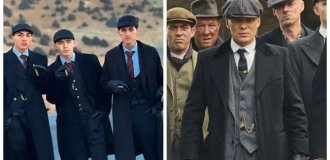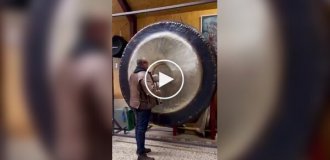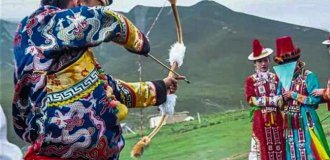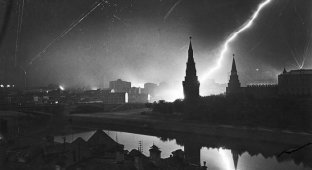Photos from the archive of the popular magazine "Ogonyok" in the USSR (101 photos)
I offer you a selection of photographs from the archives of the popular USSR magazine "Ogonyok"

DMB-1959!

Workers at the Dynamo plant listen to a message about the death of Joseph Stalin. Photo by D. Baltermants:

Admission to the Komsomol.
At a meeting of the Komsomol committee of the 33rd girls' school in Kyiv, excellent student Svetlana Karpova (standing on the right) is accepted into the ranks of the KSMU members:

Thousandth "Victory", 1946:

"Ogonyok" August 1941
Perhaps the Great Patriotic War could go down in our history as the “Holy Patriotic War”:

The first three Volgas go on a test rally across Crimea, 1955:

Signalmen during exercises. Photo by V. Gzhelsky, 1954:

In the photo: cadet Sasha Nakhimov, a descendant of the glorious Nakhimov family. Photo by Y. Khalip, 1954:
June 1954 marks the 10th anniversary of the creation of the Nakhimov Naval School in Leningrad.

Cadets. Photo by G. Sanko, 1950:
Pupils of the Tula Suvorov Military School Misha Yarygin, Kolya Romanichev and Oleg Alexandrov report to the head of the educational unit, Colonel A.N. Grishin about returning from vacation.

Figure skaters, 1961:

An airplane flies into the stratosphere, 1935:
80 years ago, Ogonyok talked about the unique flight of the American Willie Post into the stratosphere.
This outstanding pilot set a record by flying the plane to a height of 15,420 meters thanks to the fact that he was the first to wear a special spacesuit to overcome the difference in atmospheric pressure. However, the technological discovery almost cost him his life.
“All leading aviation countries are fighting for flight altitude,” Ogonyok wrote in 1935. “After all, whoever flies higher flies faster. And for military aviation, flight altitude ensures that the aircraft is less vulnerable to the enemy... Such flights require solving the most complex problems technical problems. As is known, the rarefaction of the atmosphere at high altitudes reduces the air resistance of a flying aircraft, but at the same time it is detrimental to the pilot."

Kuibyshev Suvorov School. 1957:
Excursion to a neighboring military unit. Captain G.G. Prosyankin tells the cadets the “biography” of the famous anti-tank gun, 1957:

Baker S.I. Melnikov with his family in a new apartment. Photographer Oleg Knorring, 1951:
For the baker of the Moscow factory "Bolshevik" S.I. For Melnikov, 1950 ended successfully - his large family was given a new apartment. "Ogonyok" talked about him and other new settlers. After the war, people moved into new apartments. And the difficult post-war life did not prevent them from being happy. The baker Melnikov has three children. And the master of the Gorky Automobile Plant named after. Molotov Nikolai Grigorievich Kornev - five. The youngest are twins Zina and Tanya. But all the records were broken by the car plant watchman Ivan Vasilyevich Zubrilin - he has nine children. Vladimir and Zhaneta Savitsky - he is a master, she is a design technician - just got married and are waiting for a new addition. And in the next apartment, where the family of disabled war veteran Alexei Ivanovich Kireev lives, a baby is sleeping. At home with the child, Kireev’s wife, the owner himself, thanks to Soviet doctors, restored his vision lost during the war and is now resting in a sanatorium.

Skating rink, photographer Yuri Krivonosov, 1956:

"You won't bite me?" Galina Sanko, 1955
Really scary photo. Probably, they should have written something like: “no children were harmed during filming.” Better yet, severely reprimand the photographer for such dangerous experiments with children.

In 1899, Ogonyok started as a modest supplement to the daily newspaper Birzhevye Vedomosti:
Ogonyok quickly surpassed Birzhevye Vedomosti in popularity, becoming an independent magazine in 1902 with a circulation of 120 thousand copies.

The hundred millionth bottle produced in the USSR in 1958:

In 1952, Ogonyok, in honor of the 50th anniversary of the promising party cadre, published his portrait in profile:
Georgy Maximilianovich Malenkov (1902-1988) was considered by many to be Stalin's successor. After the death of the leader, this puffy-faced party functionary headed the Soviet government for a couple of years and competed in influence with the new party leader Khrushchev. However, this duumvirate did not last long, until 1955. An attempt to take revenge in 1957 and demolish Khrushchev ended with Malenkov being completely deprived of all posts and even his very name was strictly prohibited until Perestroika. It was as if such a figure had never existed in Soviet history.

Komsomol member Anya Kapichan from the Kyiv plant "Tochelektropribor", 1963:

Anniversary parade on Red Square, 1967:

World chess champion Garry Kasparov tries to fool the Deep Blue computer, 1997:

Presentation of the Lenin Prize for Literature to Brezhnev for “Little Land” and “Renaissance”, 1980:

Young Leninists Alyosha Pilyaev and Igor Usakov. Moscow, Baltermants, 1961::

State farm field in Mukachevo region, Ukraine, 1959:

Rybinsk Sea. Diver Nikolai Lyashchenko. Photo by Mikhail Savin, 1951:

Leningrad. Moscow Victory Park, opened in 1946. 1950s:

How did Americans learn the secrets of the USSR from a photograph in the Ogonyok magazine? Here is that same photograph::
It’s paradoxical, but true: in the Soviet Union, obsessed with spymania and general secrecy, the intelligence of the United States and other countries often received extremely valuable information from open sources. For example, somewhere in the early 1960s, the KGB noticed that American embassy employees were buying bundles of literature from Akademkniga. We checked, it turned out that this was entirely fundamental research in the field of physics, chemistry, etc. Then it became known that these little books saved the American budget billions of dollars, and American scientists years of work.
In 1958, a CIA employee, using just one photograph from the Ogonyok magazine, was able to reconstruct the schematic diagram of the power supply of the entire Ural region.
The retouched photograph provided an understanding of the capacity of uranium enrichment plants (after all, the amount of energy consumed is directly related to the capacity of the plant and, accordingly, to the number of nuclear warheads produced), and also determined the location of a nuclear weapons plant in Nizhnyaya Tura, previously unknown to the Americans. Not counting other “little things” throughout the Urals.

At the Split shipyard. The ceremonial moment of laying down the tanker "Sukhumi" for the Soviet Union, 1974:

Photo of a carousel in an unknown city, Anatoly Garanin, 1950s:

Leading technologist of assembly shops engineer L.A. Sobolev (right) supervises the assembly of machine tools (automatic and semi-automatic), designed under the leadership of the chief designer of the Moscow plant named after. Sergo Ordzhonikidze, 1953:
In the USSR there was such a thing as a “labor aristocracy”. In the Stalin era, the domestic press often used the expressions “noble turner”, “noble steelmaker”, etc. Many of the heroes of labor became real Soviet “stars”.

Gorky Automobile Plant named after. Molotov. Speed turner Denis Vershinin. Photo by Mikhail Savin, 1953:

At the store window. Galina Sanko, 1961:

Construction of the Kazakh Metallurgical Plant, 1958:

“Sunday Pies”, photo by A. Garanin, 1954:
The only sign of civilization of the 20th century is a radio receiver.
I wonder what area the embroidery is from? In the USSR they were very fond of emphasizing the ethnic identity of national republics.

Tbilisi, 1956
Old Georgian cable cars, 1956 and 1963
The cable car is one of the most exotic types of transport, incl. public

Borjomi, 1963:

Dragunskaya Valentina Ottovna with her daughter Tatyana from Transbaikalia. Crimea. O. Mikhailov, 1954:

Kalinin region, Novotorzhoksky district. Collective farmer M. Klevtsov receives a loan from cashier M.V. Veresova to buy a house. Photographer Boris Kuzmin, 1955:
It is interesting to note that during the period of Khrushchev’s voluntarism, its historical name was stolen from the Novotorzhoksky district and it became “Torzhoksky” (February 1963).
The correct (historical) name for the inhabitants of Torzhok is “Novotors”.

The first Wedding Palace in the USSR, 1959:
Mechanic Pyotr Novikov and design technician Olga Bruskova got married in the newly opened first Wedding Palace in the USSR, 1959.

At the House of Culture of the collective farm “Rassvet” in the Kirov region, Mogilev region, Belarusian SSR, photo by M. Savin, 1955:

Kindergarten at the dacha. Anatoly Bochinin, 1955:

Uzhgorod University received from Moscow University as a gift supplies and equipment for the Faculty of Physics and Mathematics, 1954:

Well, and at the same time a photo of Fridland. Classes in the physics room at Uzhgorod University. 1952

Moscow State University students at a photo shoot, Evgeny Umnov, 1955:
Reproduction of the photo in Ogonyok:


Defeated Nazi fortress, 1945

Schoolboy, 1952

"Tomorrow is a day off". Pyotr Svistun and his son Vitaly were washing the Volga, getting ready to go to Stalino. Photographer Nikolai Kozlovsky, 1961:
Who forgot, in the same 1961 Stalino was renamed Donetsk.

A pioneer leader tells children about Lenin, 1951:
Entire frame and reproduction in Ogonyok, DID YOU NOTICE?:


And why did they chop off the counselor’s hand?

Winemaker-technologist Ivan Afanasyevich Aksentyuk, Moldova. B. Kuzmin, 1965:
Greedy for the sun! - the hero of this report, published in Ogonyok in 1965, spoke about the grapevine. “It is reaching ever closer to it, like a person before happiness.” At that time, the Soviet Union ranked 4th in the world in terms of vineyard area and grape wine production Modern Russia is still far from achieving such indicators...

Kindergarten on a walk, 1950s:

Collective farmer Anastasia Nikolaevna Prilepina with grain from the new harvest. Photographer Yakov Ryumkin, 1951:
A rich wheat harvest was collected this year on the Stalin collective farm in the Novo-Alexandrovsky district of the Stavropol Territory.

Members of the Russian song ensemble of the village of Istok in the Baikal region, Mikhail Savin, 1958:
“In the Baikal region, many residents preserve Russian customs and costumes,” the Ogonyok photojournalist wrote on the back of the photo. As it turns out, little has changed in Istok since those times. Fishermen are available - in the village there is a fish collection point for the Gremyachinsky fish factory. And creative groups from the village of Istok still take part in Russian song competitions.

Selling vegetables and fruits on Trubnaya Square in Moscow, Yakov Ryumkin, 1956:

Battleship "Sevastopol". On watch, Lieutenant Commander Apollo Borisovich Shumakov, 1952:
During the period of hostilities in the Black Sea, the battleship made 15 military cruises and covered about 8 thousand miles in difficult combat conditions; its main caliber guns fired 10 times (more than 3 thousand rounds) at enemy positions near Sevastopol and on the Kerch Peninsula; its anti-aircraft artillery took part in repelling 21 enemy air attacks, shooting down 3 aircraft.
Sending iron and flame to enemies,
You fought with honor in a stubborn battle.
For the city whose name you bear as a banner,
For your native shore, for your Fatherland.
© V. I. Lebedev-Kumach

Agitator Zoya Titova reads a magazine to Udmurt collective farmers, Malo-Purginsky district, photo by Mikhail Savin, 1950:

Komsomol members of the Vasileostrovsky district pack gifts for virgin lands, Nikolai Ananyev, 1955:

In Pavlov on Oka, indoor lemons can be found everywhere, even in the chemical laboratory, photo by A. Roshchupkin, 1952:

"Metallurgists" This wonderful photograph, unfortunately, was also posted without indicating the date, authorship or place of shooting:

Kerch fish processing plant, 1955:

"Young Builders of New China". Dmitry Baltermants, 1954
Now they produce more than 20 million cars a year and have already overtaken the United States in terms of GDP...

A family of Heroes of Socialist Labor gathered at the table on the collective farm named after. Beria, Georgia, photo by N. Kozlovsky, 1951:
Raising a toast with a glass of tea in Georgia is strong!

"At the post". The guard duty is performed by an excellent student, Private Abdula Akhmedov. photographer V Gzhelsky, 1954:

"Fun Concert", S. Raskin, 1956:
Close-up version and reproduction in Ogonyok with clever photomontage:



“Happy New Year, comrades!”, Yakov Ryumkin, 1954:

New Year, N. Kozlovsky, 1961:

Mother and child at the New Year tree, 1971

Youth New Year's ball at Moscow State University, I. Terkel, 1979:

Moscow New Year, 1980:

Moscow factory of glass Christmas tree decorations, B. Kuzmin, no date:

Opening of the Russian Winter holiday, B. Kuzmin, 1963:

Russian winter holiday in the city of Sudzha, Kursk region, B. Kuzmin, 1969:

Botsman I.E. Bezrodny talks about the heroic past of Sevastopol, Nikolai Verinchuk, 1954:
Cape Khrustalny is still pristine!


"New Year", 1953:

Students on factory practice, 1953:
“Comrades are listening to the report of a 5th year student of the Mechanical Faculty of the Saratov Automobile and Highway Institute, Comrade I.I. Timofeev, at the scientific and technical circle of the Department of Mechanical Engineering Technology on the topic: “Research of methods of grinding metals and methods of eliminating them.” The topic is carried out as a social assistance to the Hammer and Sickle factories and the 3rd State Bearing Plant. On the left is I.I. Timofeev, in the middle is the head of the circle, associate professor Sergei Georgievich Redko,” Ogonyok wrote 60 years ago. After 10 years, Sergei Georgievich became a professor, and even later received the title of Honored Worker of Science and Technology of the RSFSR and the Order of the Red Banner of Labor for his great contribution to the development of science and technology and the creation of a scientific school. His name is included in the Book of Honor of the Saratov Polytechnic Institute. How the professional fate of the future young specialist “Comrade Timofeev” turned out, unfortunately, is unknown. And the institute has gone through several renamings, now it is, as it should be nowadays, Saratov State Technical University named after. Gagarin.

On the construction of the Lanzhou-Alma-Ata railway, Dmitry Baltermants, 1954:
— A donkey is also a machine, obedient to drive. Shall we exchange? - the peasant offers the driver of the dump truck.
And this is how Ogonyok readers saw this photo:


In the family of the driver of the Svalyavsky timber industry enterprise Ernst Wagner. Wife Klara, son Fyodor, daughter Katya, photo by Nikolai Kozlovsky, 1954:
“The driver of the Svalyavsky timber industry enterprise, Ernst Wagner, has just finished his shift. But a new “job” awaits him at home: he needs to help his wife buy her daughter,” Ogonyok wrote, talking about the new, socialist life of Transcarpathia, which only 10 years ago joined the Soviet family of nations . The features of the new life in the timber industry enterprise are obvious: firstly, there is no profession of lumberjack, there are electric sawers, winch operators and tractor skidders. Secondly, socialist planning put an end to the plunder of forest resources. But traditions are also alive - timber industry workers wear green branches behind their hat ribbons, just like their fathers. “Their life has become completely different,” concludes Ogonyok.

Showcase of young performers at the Belarusian Drama Theater named after. Yanka Kupala. Minsk. Photo by Mikhail Savin, 1953:

DMB-1959:
I was very intrigued by the timing of this photograph, but fortunately, I almost immediately came across it on the cover of Ogonyok magazine:


Moscow Tool Plant. The innovator is the blacksmith Ivan Vasilievich Krygin and the designer Nina Yuryevna Bukashkina, who helps him in implementing his proposals. O. Knorring, 1953:

Guard junior sergeant V. Agapov is the commander of one of the best crews of the N Guards unit. Photographers G. Makarov, A. Stanovov, 1952:

"Senior Sergeant V. Perekrasov on patrol. The border never sleeps", Nikolai Verinchuk, 1954:

Leo Tolstoy's coachman Ivan Egorov and the pioneers, 1954:
Alas, the author of the photo is not indicated.
The count's coachman Ivan Egorov survived both his master and even the Great Patriotic War. And long after the war he rode horses in Tolstoy’s estate, remaining a living landmark of Yasnaya Polyana. There he was met in 1954 by Ogonyok correspondents who came to write about the local school. “Ivan Vasilyevich Egorov... he worked as a coachman for Tolstoy. He even took pictures with him,” the schoolchildren told them.
Uncropped photo:


In the evening on the Yalta embankment, Isaac Tunkel, 1954:

"The arrival of the teacher", Dmitry Baltermants, 1950:

“I will also be a miner!”, Dmitry Baltermants, 1954:
A tattoo of a naked woman is clearly visible on the man’s arm. However, in 1954, Ogonyok published this photograph with the caption “I, too, will be a miner!” without any naked woman - the tattoo was retouched.

An ancient tractor from the Ogonyok archive, an untitled photograph taken somewhere in the USSR in the 1950s:

"Spaniard". Festival Moscow 1957:
The question arises: where did the Spanish delegation come from in Moscow in 1957, if relations between Spain and the USSR were almost completely interrupted until Franco’s death in 1975?

One of the latest finds is a charming view of Warsaw circa the mid-1950s:

I came across a photo from the Ogonyok archive, they write that Novosibirsk:

Workers of the Kolomna Locomotive Plant named after. Kuibyshev signing the appeal of the World Peace Council on the conclusion of the Peace Pact, Isaac Tunkel, 1951:
























